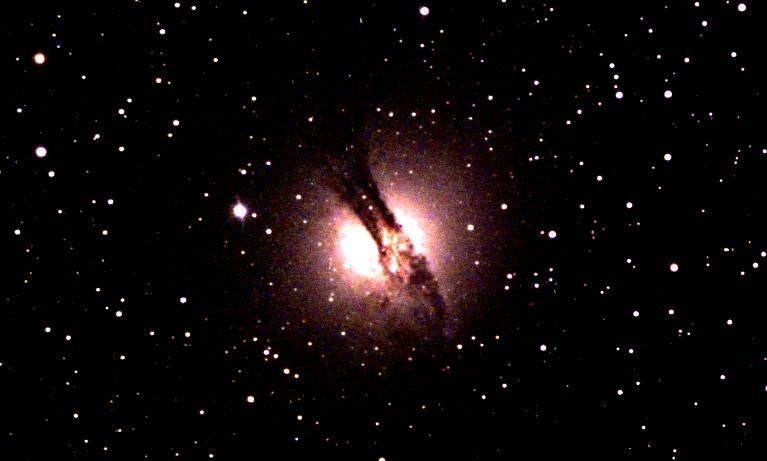
The galaxy known as Centaurus A, and designated NGC 5128, shines at 7th magnitude and is one of the brightest galaxies visible in the southern sky. This extraordinary galaxy is a giant elliptical galaxy with an unusual elliptical dust band. This peculiar galaxy is believed to have formed from the head-on collision of two galaxies about a billion years ago. A giant elliptical galaxy collided with a spiral galaxy. The broad dust band across the center of Centaurus A is the remnants of that spiral galaxy after the catastrophic merger, and it is all that remains of the spiral galaxy that was consumed by the giant elliptical galaxy. NGC 5128 is located about 15 million light-years away. It is a massive galaxy. Centaurus A has a mass of more than 200 billion suns. The diameter of the elliptical galaxy is about 100,000 light-years. The dark dust lane is about 4,000 light-years wide in the area immediately in front of the nucleus, and about 8,000 light-years wide at the southeast edge. Centaurus A is a strong source of radio energy. It appears to have a massive black hole at the center of the elliptical, and is shooting jets of gas and material out from the nucleus. It is located about 4-1/2 degrees away from the Omega Centauri Star Cluster.
This is an LRGB composite CCD image taken at prime focus on a Takahashi FS-128 refractor at f8. An SBIG ST-8 CCD was used, with a Homeyer color filter wheel. MaxIm DL/CCD was used for image acquisition and most image processing, and Picture Window 2.5 was used for the LRGB composition.
NGC 5128
Constellation: Centaurus
RA: 13h 25m 27.8s Dec: -43d 00' 48"
March 22, 1999
Image by Sid Leach
Iola, Texas
Recent Images.
Complete list of images.
Description of equipment used to acquire images.
Home
Feedback and comments should go to Sid